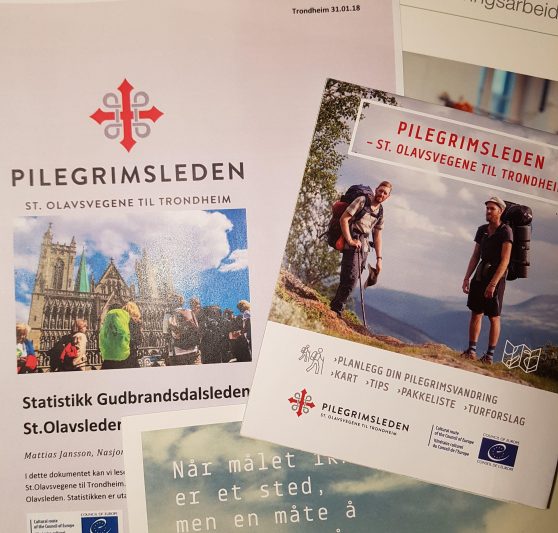National Pilgrim Center
The National Pilgrim Center is responsible for the public pilgrimage development in Norway, coordinating and prioritizing tasks and resources. The public pilgrim routes in Norway are meant to function as incubators for positive and sustainable development. The pilgrim routes are open for all.

Foto: Øystein Moe/Helmet
Mandate and organization
The National Pilgrim Center is organized as a department within the Nidaros Cathedral Restoration Workshop, which in turn is an agency under the Ministry of Culture.
The mandate and framework are governed by an annual allocation letter from the ministry, based on the stately Long-term plan for Pilegrimsleden from 2019 and the National pilgrimage strategy from 2012.
National Pilgrim Center (NPS)
The National Pilgrim Center has overall responsibility for the national pilgrimage initiative, including the coordination of tasks and resource use. The pilgrimage work aims to contribute to value creation and positive development along the St. Olav Ways to Trondheim. It should have a clear ecclesiastical foundation while being open and inclusive to people of different faiths, cultures, and traditions.
NPS is tasked with managing and promoting the cultural heritage of the Pilegrimsleden - The St. Olav Ways to Trondheim as a sustainable and environmentally friendly experience, rooted in the European pilgrimage tradition. NPS aims to make Pilegrimsleden an attractive and preferred pilgrimage route in Europe.
This will provide today’s and tomorrow’s pilgrims with the opportunity for a unique and environmentally friendly journey through Norwegian nature and cultural landscapes, along historical routes with deep roots and traditions, stepping out of the hustle and into slow time, a space for reflection and seeking.
Means to achieve these goals:
- Well-marked routes with good infrastructure.
- Sufficient accommodation capacity with controlled growth to match annual visitor numbers.
- Open churches and good dissemination of cultural heritage along the route.
- Effective systems for monitoring traffic and activity.
- Good cooperation and role clarification with various stakeholders and actors involved in pilgrimage work.
- Local and regional anchoring and ownership of the work.
- Clear and effective communication.
-Strong international profile and affiliation, including further development of the status as a European Cultural Route
- Further development of Nordic cooperation and the network of St. Olav Ways.
The framework for the state pilgrimage initiative consists of strategies and long-term plans that guide its direction, organization, and priorities.
The National Pilgrimage Strategy (2012):
Established in collaboration between five ministries, the 2012 strategy laid the groundwork for the state pilgrimage initiative. It identified overarching goals and strategic priorities for the development of pilgrim trails and supporting infrastructure.
The state pilgrimage initiative emphasizes four key areas—environment, business, church, and culture—to ensure holistic and sustainable development of the pilgrimage efforts. By integrating environmental sustainability, economic development, spiritual engagement, and cultural preservation, the state pilgrimage initiative creates value for pilgrims, local communities, and the broader society.
The Long-Term Plan for the Pilgrimage Initiative (2019):
Commissioned by the Ministry of Culture, this plan builds on the 2012 strategy with more specific recommendations for organization, financing, and resource use, while setting a 20-year perspective for the initiative's future development.
Key Focus Areas: Clearer organization and division of roles, sustainable financing models, enhanced coordination across regional, national, and local levels, and further development of trails, infrastructure, and partnerships.
The long-term plan serves as the main steering tool, ensuring that the pilgrimage initiative continues to develop in line with national goals while adapting to current and future needs.
Langtidsplan for pilegrimssatsning (Long-term plan, Norwegian only)
Strategi for pilegrimssatsing 2012 (2012-strategy, Norwegian only)
Vedlegg 1, 2 og 3 til strategi for pilegrimssatsing 2012 (attachtments to the 2012-strategy, Norwegian only)
A central part of the national pilgrimage initiative is the regional pilgrimage centers. While the national center has overall responsibility for coordinating and prioritizing resource use and tasks, the regional centers serve as the link between stakeholders in their respective regions and act as the operational arm along Pilegrimsleden. The centers are organized as independent entities or departments within established organizations and receive state funding as part of their financing.
The centers actively collaborate with municipalities, county authorities, tourism and business stakeholders, congregations of various denominations, volunteer organizations, landowners, and cultural institutions within their region. Monitoring trail marking and maintenance, as well as following up and further developing the network of small and large business operators, is a core task.
The centers are also responsible for providing guidance and information about the trail and travel within their region
Read more about all 12 regional centers on the overview page: Regional pilgrim centers

Reports and statistics

The Pilgrim Reception
The Pilgrim Reception at Nidaros Cathedral welcomes and registers pilgrims upon their arrival. Since its establishment in 2010, over 14,000 pilgrims have been officially registered. Learn more about their travels, economic impact and more.

Marking and maintenance
The Marking Handbook for Pilegrimsleden - St. Olav Ways to Trondheim is a guide for counties, municipalities, and marking teams along the pilgrimage routes, with the Nidaros Cathedral in Trondheim as the final destination. The Marking Handbook 2015–2018 remains in effect until a revised version is published (in 2025).
Marking handbook (Norwegian only)
Marking system (Norwegian only)
Practical guide for marking work (Norwegian only)

Projects

Logo og profil
Logoen er det offisielle merket til Pilegrimsleden – St. Olavsvegene til Trondheim. Logoen brukes til å merke og promotere de offisielt godkjente St. Olavsvegene, og er hovedelementet til Pilegrimsledens grafiske profil. All bruk av logoen skal godkjennes av NPS, som eier og forvalter denne. Sissel Nervik kan kontaktes for søknad om logobruk.

Cultural Route of the Council of Europe
The Norwegian National Pilgrim Center, in collaboration with the Norwegian University of Life Sciences, has prepared a sustainability analysis of the Pilgrimsleden trails.
Master's thesis for NMBU, The sustainable development of the pilgrim trail, by Mattias Jansson, 2021
This was written as an independent, objective master's thesis however its findings and results, as well as its recommendations, may also be relevant for other pilgrim trails.
For any questions, e-mail mattias.jansson@pilegrimsleden.no
Read the abstract here:
"Sustainable development of the Pilgrim Trails”
Interest in pilgrimage and the use of pilgrim trails has flourished in recent years, both in Norway and abroad. The increasing number of pilgrims in Spain has necessitated the development of plans and strategies to safeguard the sustainability of these areas. Along the Pilgrim trail between Oslo and Trondheim, the number of pilgrims has increased annually by about 20%. This trail leads through vulnerable nature and in close proximity to cultural landscapes. The need for research that examines challenges and opportunities involved in further sustainable use of the trail must also be addressed here.
This master's thesis examines the types of situations and uses impacting the sustainability of the St. Olav’s Route “Gudbrandsdalsleden” between Oslo and Trondheim. This includes the impact on the natural and cultural environment, attitudes towards infrastructure, sustainability measures and environmental certifications related to UNWTO's strategy for sustainable tourism. I have conducted two surveys and answered four questions that deal with these topics. The data is based on a quantitative survey of hikers on the Pilgrim trail, as well as a qualitative survey with interviews of ten participants who work with or in the vicinity of the trail. Results of the quantitative survey show that the most important factors for a pilgrimage are to experience nature and a desire to walk in peace and quiet. The 120 respondents walked an average of 16 days. They show little purism and express preferences for a good infrastructure with good signage, marked trails, planking and rest stops and also showed positive attitudes towards sustainability and environmental certifications. Statistical analyses show that the answers from Norwegian and foreign pilgrims are generally similar, the exception being that foreign pilgrims to a greater extent wanted to “walk alone” and “walk for miles without meeting others”. They also believe to a greater extent, that it is difficult to be environmentally friendly along the trail. The qualitative study reveals initially positive views of the pilgrim trail for the regions through which it passes, but that there is also some degradation of the natural and cultural environment; this being associated with camping, water erosion of paths and variation of central infrastructure. The participants also wanted greater focus on the availability of information along the trail, as a means of strengthening sustainability and an infrastructure that takes greater care of the existing cultural landscape.
The thesis discusses challenges associated with pricing, the role of hosts, waste disposal and toilet facilities as well as challenges associated with the right of public access. The thesis concludes with recommendations for developments in infrastructure, dissemination of information and channelisation. It also encourages greater network building as well as greater use of environmental certification schemes.
Key words: sustainable development, infrastructure, environmental certification, Pilgrim Trail, St. Olav’s route to Trondheim, hiking trails.
Ansatte

